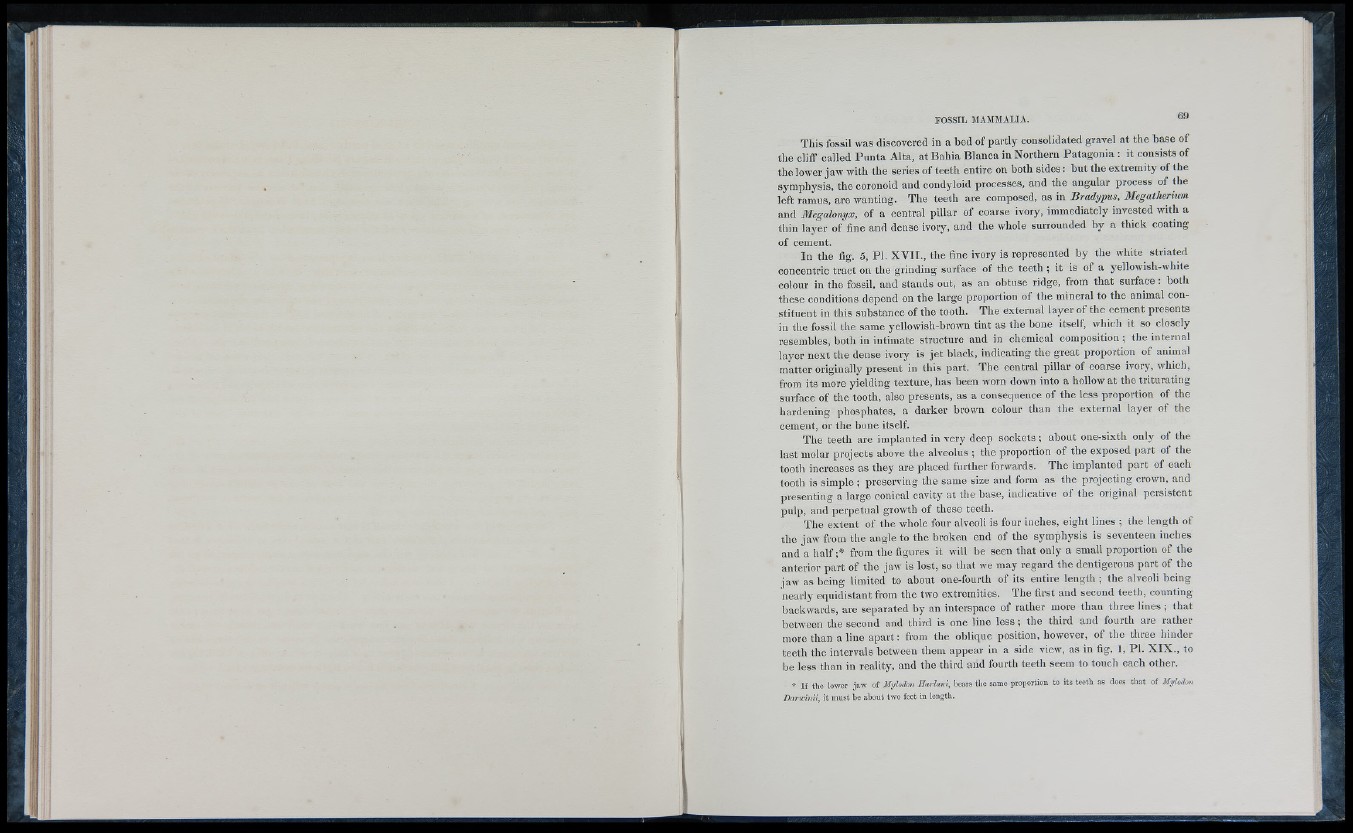
This fossil was discovered in a bed o f partly consolidated gravel at the b a se o f
the cliff called Pu n ta Alta, at B ahia Blanca in Northern Patagonia ; it consists of
thelower jaw with the series o f teeth entire on both sides: but the extremity of the
symphysis, the coronoid and condyloid processes, and the angular process o f the
left ramus, are wanting. The teeth are composed, as in Bradypus, Megalherium
and Megalonyx, o f a central pillar o f coarse ivory, immediately invested with a
thin layer o f fine and dense ivory, and the whole surrounded by a thick coating
o f cement.
In the fig. 5, PI. X V I I ., the fine ivory is represented hy the white striated
concentric tract on the grinding surface o f the teeth ; it is o f a yellowish-white
colour in the fossil, and stands out, as an obtuse ridge, from that surface : both
these conditions depend on the large proportion o f the mineral to the animal constituent
in this substance o f the tooth. The external layer o f the cement presents
in tlie fossil the same yellowish-brown tint as the bone itself, which it so c lose ly
resembles, both in intimate structure and in chemical composition ; the internal
layer next the dense ivory is je t black, indicating the great proportion o f animal
matter originally present in this part. The central pillar of coarse ivory, which,
from its more y ielding texture, has been worn down into a hollow at the triturating
surface o f the tooth, also presents, as a consequence o f the le ss proportion of the
hardening phosphates, a darker brown colour than the external layer o f the
cement, or the bone itself.
The teeth are implanted in very deep so ckets ; about one-sixth only o f the
last molar projects above the alveolus ; the proportion o f the exposed part o f the
tooth increases as they are placed further forwards. T h e implanted part o f each
tooth is simple ; preserving the same size and form as the projecting crown, and
presenting a large conical cavity at the base, indicative o f the original persistent
pulp, and perpetual growth o f these teeth.
The extent o f the whole four alveoli is four inches, eight line s ; the length o f
the jaw from the angle to the broken end of the sym ph y sis is seventeen inches
and a h a lf;* from the figures it will he seen that only a small proportion o f the
anterior part o f the jaw is lost, so that we may regard the deutigerous part of the
jaw as being limited to about one-fourth o f its entire length ; the alveoli being
nearly equidistant from the two extremities. The first and second teeth, counting
backwards, are separated by an interspace o f rather more than three lines ; that
between the second and third is one line le ss ; the third and fourth are rather
more than a line a p a r t: from the oblique position, however, of the three liinder
teeth the intervals between them appear in a side view, as in fig. 1, PI. X IX ., to
be le ss than in reality, and the third and fourth teeth seem to touch each other.
• I t «10 lower jaw ot Mylodm Harlani, boars tlie s.amo proportion to its tooth as does that ot Myhxhn
Daricinii, it must be about two feet in length.